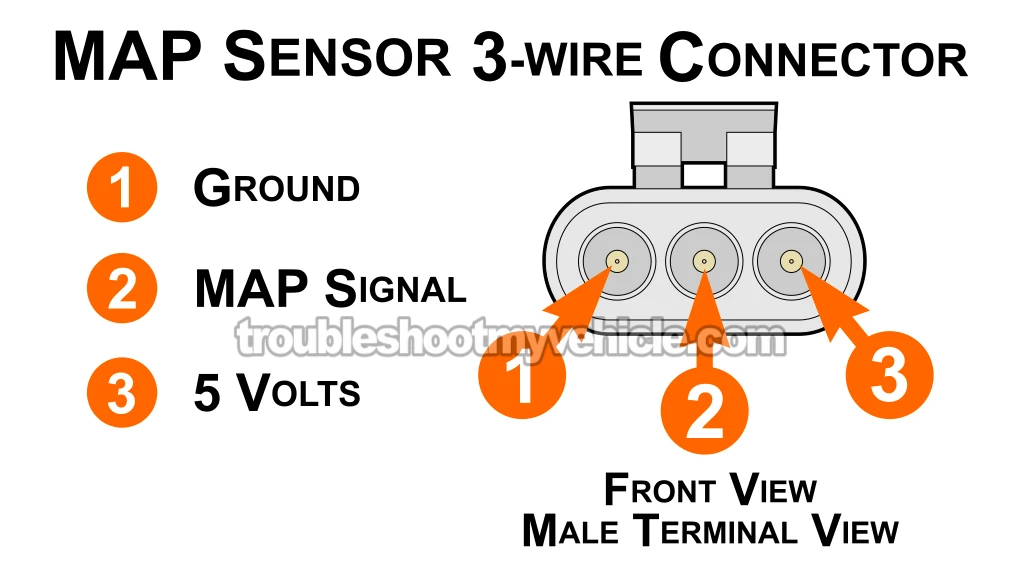TEST 3: Verifying The MAP Sensor Ground Circuit

The previous two tests have confirmed:
- The MAP sensor fails to produce a variable voltage signal when vacuum is applied/released to it (TEST 1).
- The MAP sensor is receiving power, specifically 4.5 to 5 Volts DC (TEST 2).
For our final test, we're gonna check that it's receiving Ground from the black with light blue stripe (BLK/LT BLU) wire of the MAP sensor's 3-wire connector.
This test is quite straightforward, and it also involves using our multimeter again (for a voltage test).
IMPORTANT: The BLK/LT BLU wire connects directly to the fuel injection computer, so be careful and avoid shorting this wire to battery power (12 Volts). Otherwise, you're gonna fry the computer. The multimeter voltage test I'm suggesting in the instructions is a safe way to check for Ground in the wire (circuit).
These are the test steps:
- 1
Disconnect the MAP sensor from its electrical connector.
- 2
Connect the red multimeter test lead to the battery positive (+) terminal.
- 3
Set your multimeter to Volts DC mode.
- 4
Turn the key ON but don't start the engine.
- 5
Probe the terminal marked with the number 1 using the black multimeter test lead.
NOTE: Double-check that this terminal corresponds to the BLK/LT BLU wire. - 6
Your multimeter should display 10 to 12 Volts DC.
Here's what your results tell us:
CASE 1: Your multimeter registered 10 to 12 Volts. This confirms that the MAP sensor is receiving Ground from the computer.
This points to a faulty MAP sensor that needs to be replaced only if you have confirmed:
- The MAP sensor fails to generate a variable voltage signal when you apply/release vaccum to it (TEST 1).
- The sensor is getting power (TEST 2).
- The sensor is getting Ground (this section).
To save a few buck on the sensor, check out my recommendations: Where To Buy The MAP Sensor And Save.
CASE 2: Your multimeter didn't register 10 to 12 Volts. Double-check all your connections and retest.
If you still don't see the indicated voltage, you've found the reason the MAP sensor isn't generating it's variable voltage signal (when you apply/release vacuum to it).
This tutorial doesn't cover how to find the cause of this missing Ground, but you've already taken a big step: you've ruled out the MAP sensor itself as bad.
Your next step is getting that Ground supply back to resolve the MAP sensor issue. The most common reasons this Ground is missing are:
- The Ground supply wire is damaged between the MAP sensor's 3-wire connector to the fuel injection computer.
- It's also possible, but very rare, that there's an internal fault within the computer itself.
MAP Sensor Code Won't Go Away
OK, so you've checked the MAP sensor and it seems to be working correctly. But you're still getting that annoying check engine light, even after you've cleared the diagnostic trouble code (DTC) from the computer's memory. To continue figuring this out, here are a couple of things that could be causing the issue:
- Major vacuum leak: A major vacuum leak is causing the air/fuel mixture to lean out, leading to a rough idle and the FI computer mistakenly thinking your MAP sensor is the problem.
- Damaged vacuum hose: This is the rubber hose connecting MAP sensor to the vacuum outlet nipple on the intake manifold, it's likely got dry rot or even a break.
- Low engine compression: You've got low engine compression in several cylinders, which is causing a rough idle and inconsistent intake manifold vacuum. To check this, I recommend performing a compression test:
- Intermittent MAP sensor failure: The MAP sensor is failing intermittently –it works great most of the time, but sometimes it doesn't. To test this, try gently tapping the sensor with a screwdriver handle while applying vacuum. If tapping glitches the voltage readings, you've found the problem.
- Damaged MAP sensor connector: The MAP sensor's connector's probably bad. Usually, the locking tab is broken, and the connector has come loose, leading to intermittent connection issues.
- Bad Fuel Pump: Your fuel pump is starting to fail and isn't delivering enough fuel or fuel pressure to the injectors. Check the fuel pressure and make sure it's within specification:
More 3.9L V6 Dodge Ram Van Tutorials
I've written several more tutorials that may be of interest to you that you can find in this index:
Here's a sample of the tutorials you'll find in the index:
- How To Test For A Blown Head Gasket (1989-2003 3.9L V6 Dodge Ram Van).
- How To Test The Engine Compression (1989-2003 3.9L V6 Dodge Ram Van).
- How To Test The Fuel Pump (1992-2003 3.9L V6 Dodge Ram Van).
- How To Test The TPS (1989-1990 3.9L V6 Dodge Ram Van).

If this info saved the day, buy me a beer!

